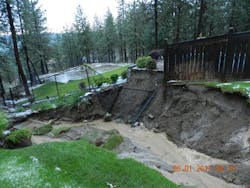Streets in Spokane, Wash., became rivers during an early summer storm in 2011. In one neighborhood, the rainfall was so great that it filled a swale, jumped the weir and forcefully eroded the hillside below. Residents watched parts of their backyards and fencing get swept away.
After the storm had passed, homeowners turned to the City of Spokane Wastewater Management Department to assess the damage. The crew thoughtfully approached the project and constructed a functional and aesthetically appealing storm water drainage solution to restore the area and prevent future damage.
During the Storm
The massive quantity of rainfall inundated the storm system on Skyline Avenue and then flooded the grassy bio-infiltration swale below. Principal engineer Mike Yake estimated the flow of the storm water at 400 cu ft per second. This powerful volume flowing into the swale was not exclusively due to the storm’s magnitude, but also was due to the street drainage design. Storm water runoff came from three directions before reaching several H-unit catch basins. The catch basins were surcharging 1 ft because the pressure was so immense. The grassy swale below the street (approximately 100 ft in length, 12 ft in width and 18 in. in height) was quickly filled to capacity.
At that point, the storm water jumped the weir and forcefully eroded the slope below, creating a 15-ft-wide, 10-ft-deep gully. Homeowners lost their backyard fences and some landscaping. One homeowner nearly lost his swimming pool. Debris and sloughed soil then traveled at least a quarter mile before slowing at flatter elevations.
The Aftermath
The construction crew of the wastewater department was called the next day to assess the damage. Rob Jamison, construction crew leader, thought, “It couldn’t be that bad,” until he saw the damage. Initially, he was overwhelmed, knowing his crew had never taken on such a project. The crew wanted to ensure that such heavy erosion would not happen again, so they decided to extend the swale and build cascading steps to reduce the water’s flow.
The crew began by excavating a road to access the eroded drainage. They removed leftover debris and the previous retaining wall below the swale. After adding 10 ft in length to the swale and leveling the side and back walls, they lined the space with filter fabric to prevent future erosion.
The freshly lined space was filled 8 ft tall and 16 ft wide with ecology blocks. Stone gabions were built into the ecology blocks to form cascading steps. The steps were designed to reduce the storm water momentum while also allowing some water to filter through. The steps also needed to line up with the outfall pipe from the swale. Additionally, the steps created a spiral staircase effect to deflect water flow from nearby trees.
After cleaning out the channel and removing excess sediment, individual rocks were placed to guide the water from the gabion steps around the trees and down the valley. Culverts were added for the hiking and biking trail that traversed the river bed, and everything was raked out smoothly.
The Falls
The finished project created a long-term storm water runoff solution that also added beauty to the neighborhood. Jamison said the neighbors expressed concern in the early stages of the project, but as the project progressed, they hosted neighborhood field trips. During one of the trips, crew member Mike Look casually referred to the project as Weile Falls. Later that week, one of the neighbors posted a hand-carved sign on the cascading falls with the new name. Another neighbor added a rustic bench and has plans to add a scarecrow dressed up like a fisherman.
In March of 2012, another intense storm hit Spokane. Afterward, Weile Falls was assessed, and no damage or erosion was found. The storm water had filled the extended swale and overflowed into the cascading falls. It appeared that the storm water had soaked through the first rock gabion on the falls, helping dissipate flow rate and volume. Given the magnitude of this most recent storm, it appears that Weile Falls will be a durable, long-lasting solution.
Completion of Weile Falls can be attributed to the hard work of the wastewater management department of the city of Spokane.
Meredith Noble was Stormwater Public Outreach and Education Coordinator for the city of Spokane, Wash. Noble has since left the organization. For more information, contact Gary Kaesemeye, Supervisor of Sewer, Stormwater Maintenance & Construction, at [email protected].
Download: Here


